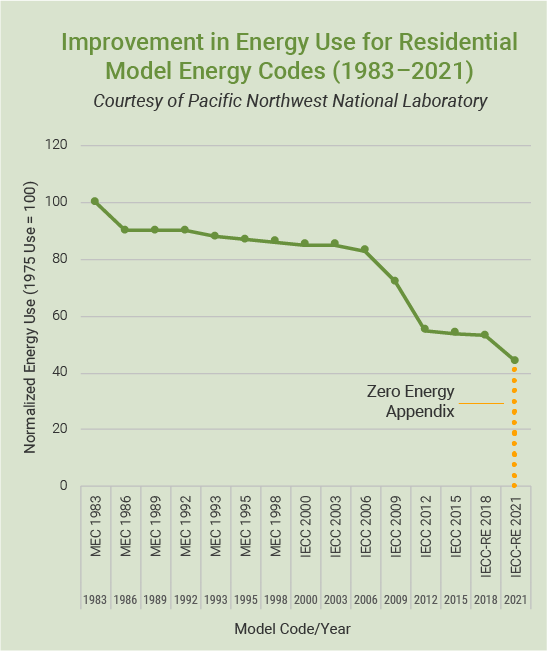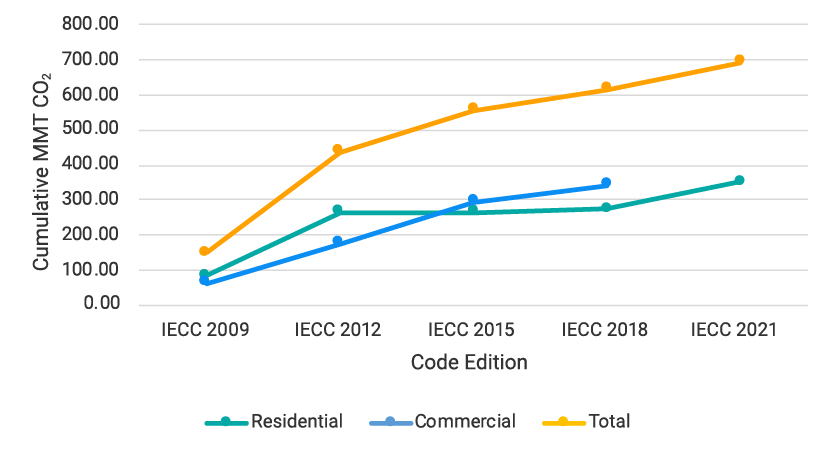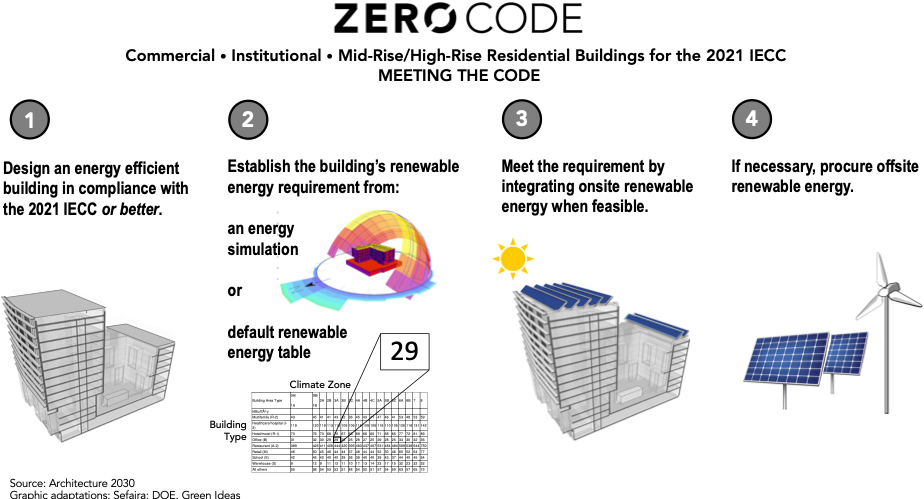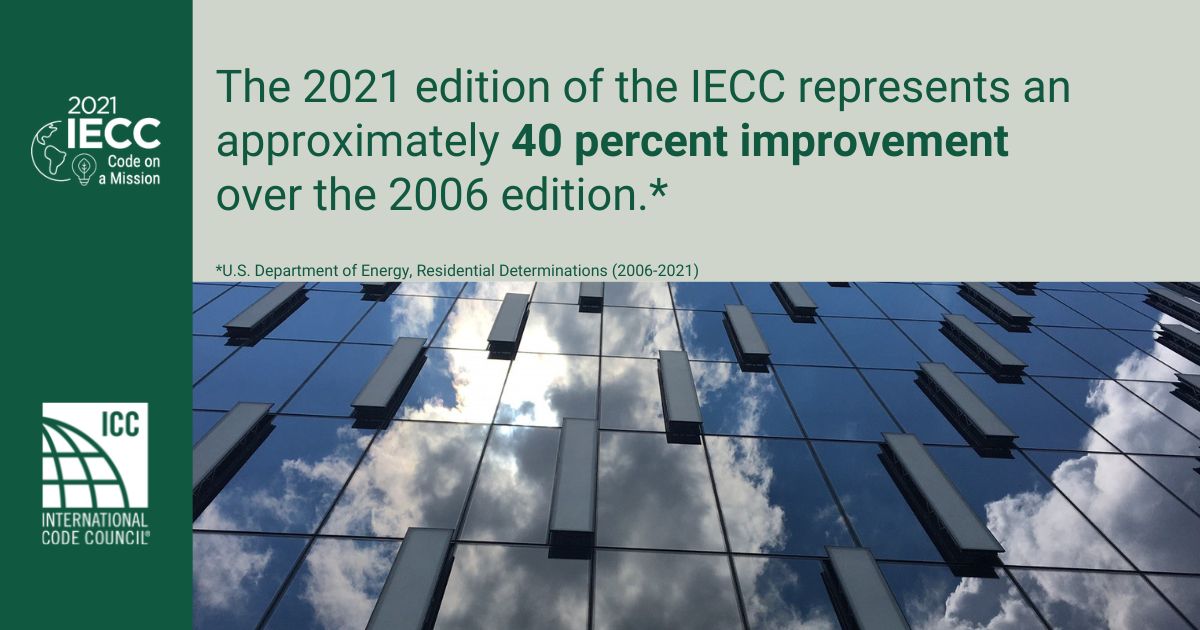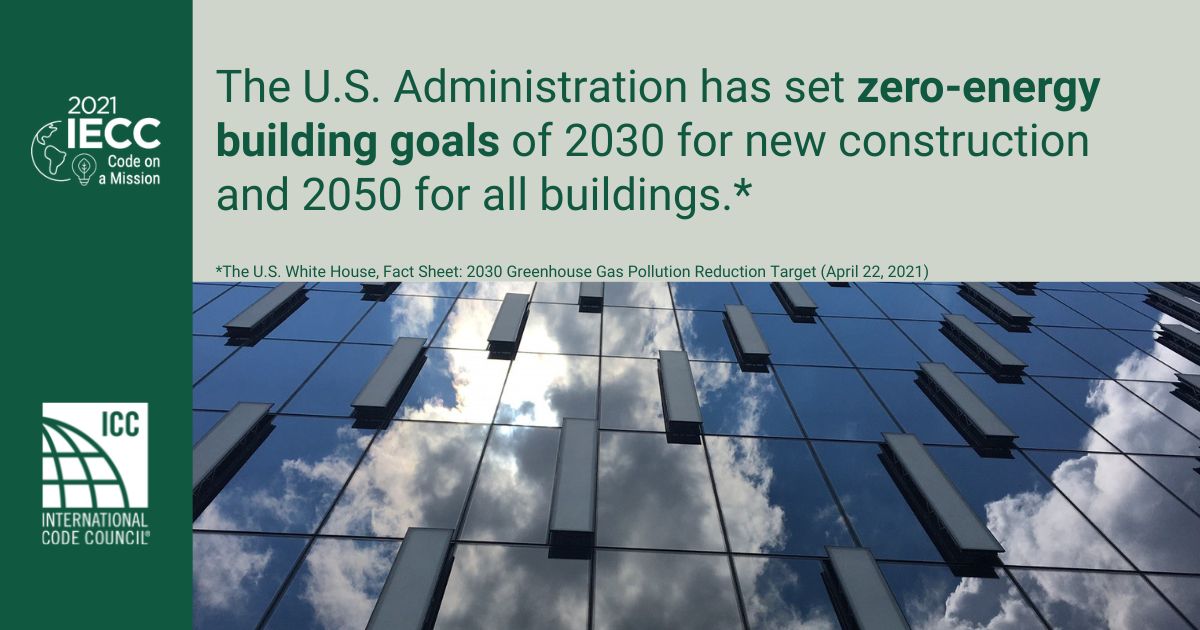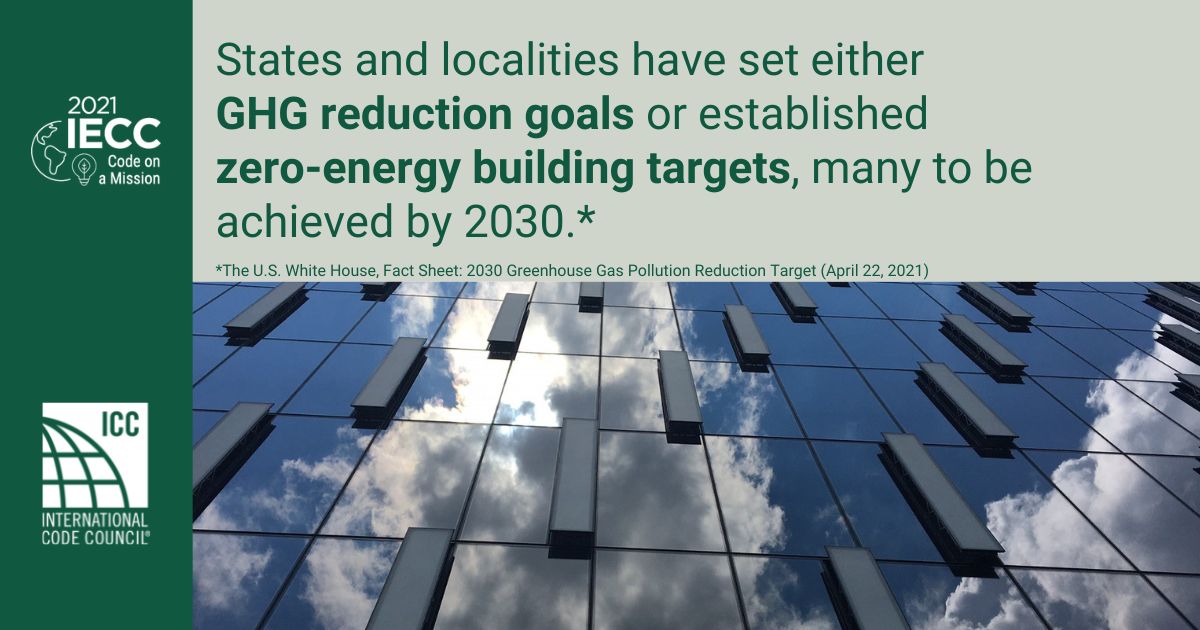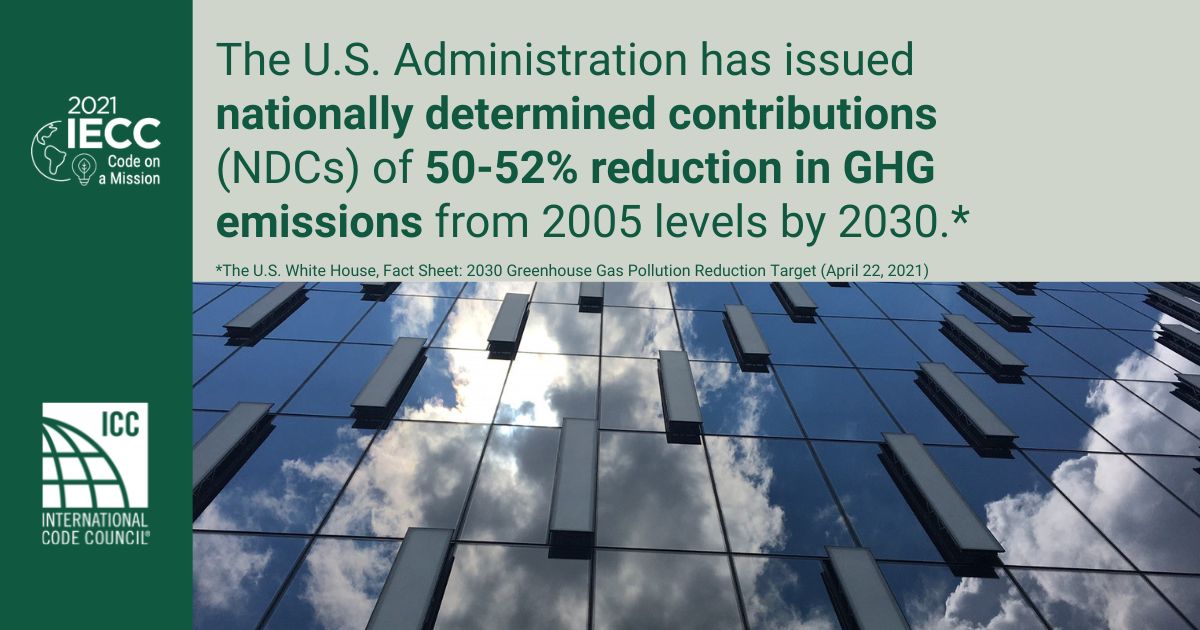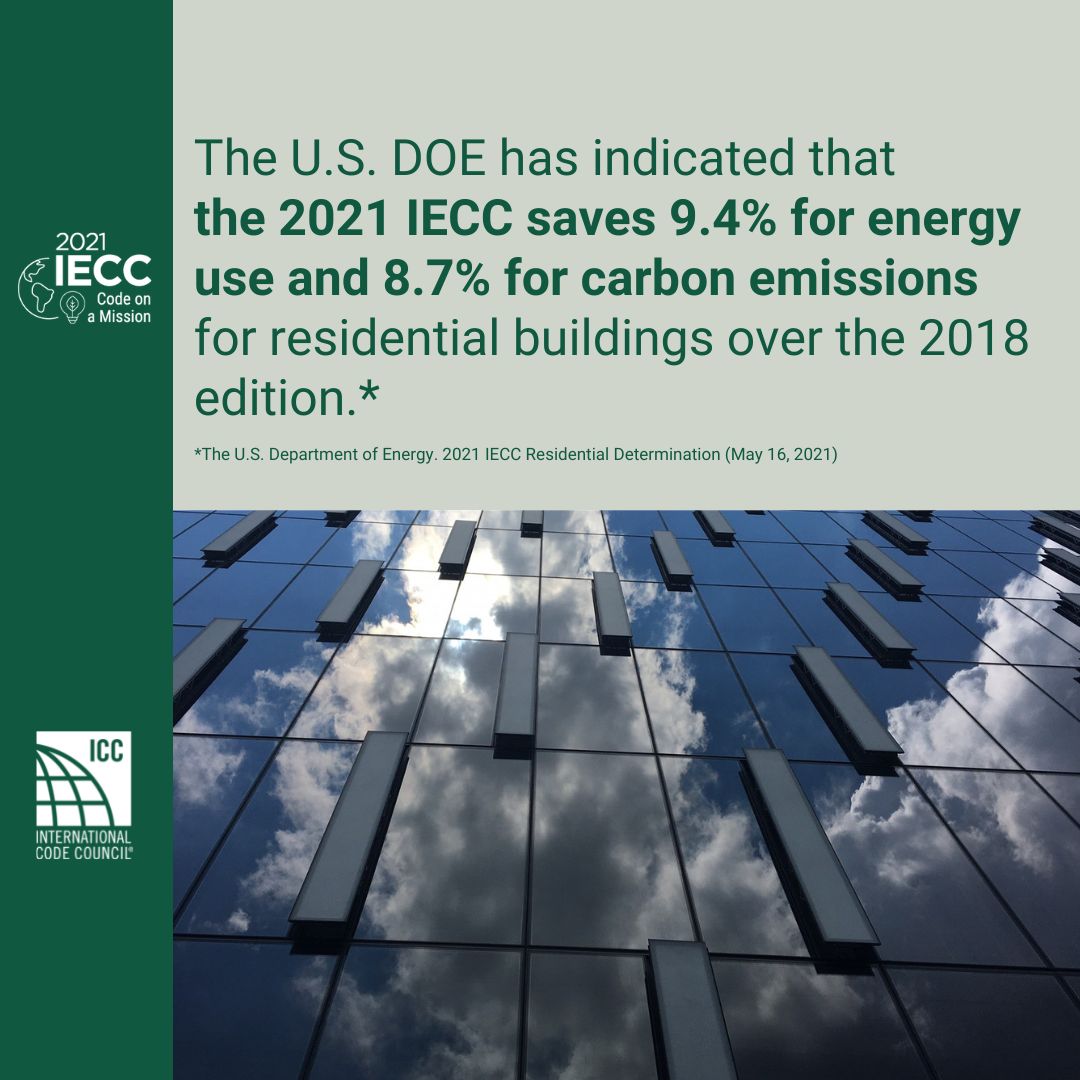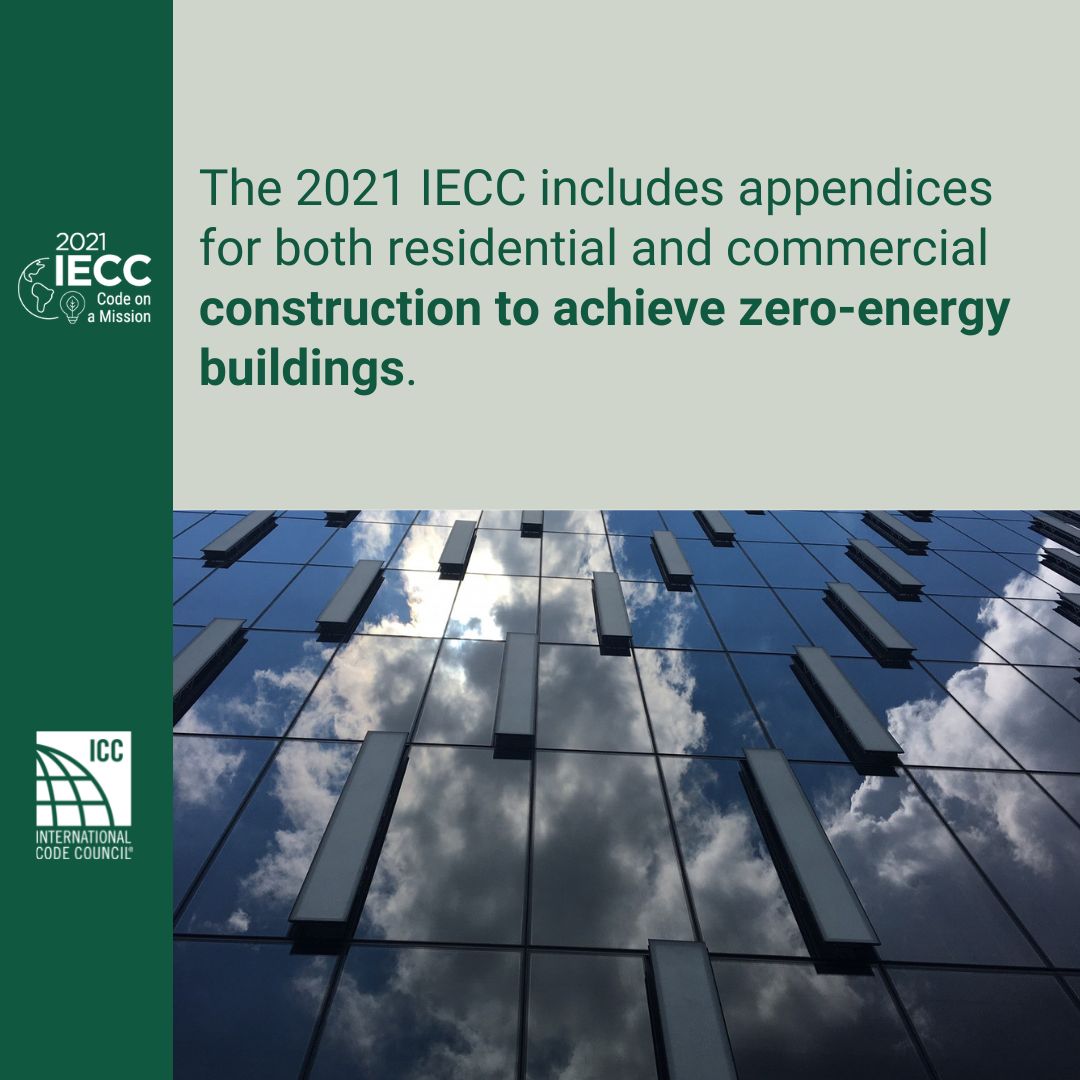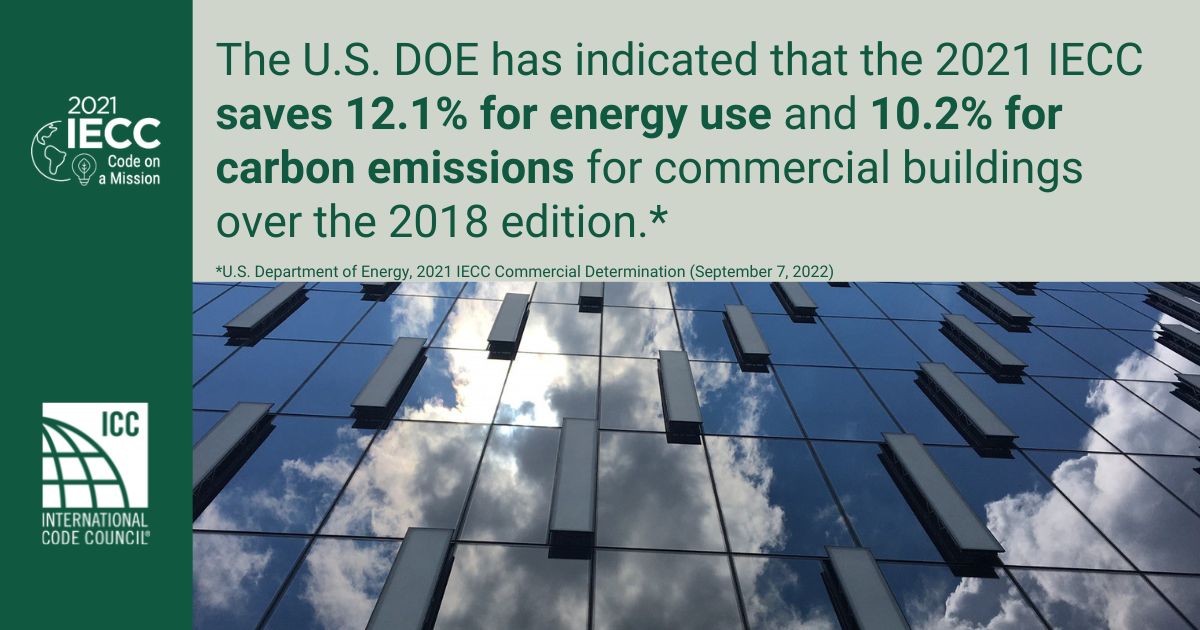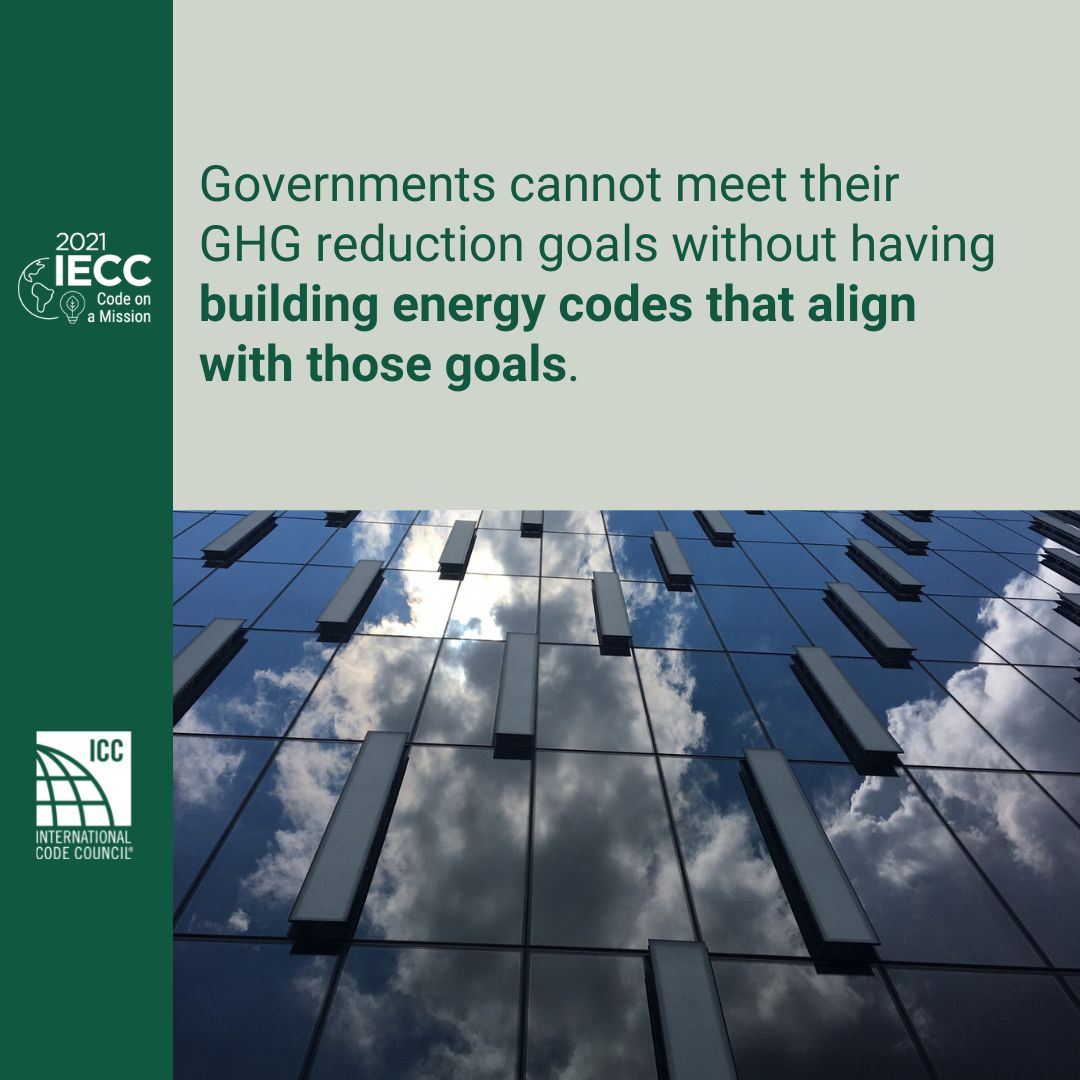
2021 IECC: A Code on a Mission – Campaign Toolkit
This Code on a Mission Toolkit supports communities and advocates with adoption of the 2021 IECC and its appendices and consideration of the 2021 IgCC. The toolkit includes the following resources:
Reasons for adopting the 2021 IECC
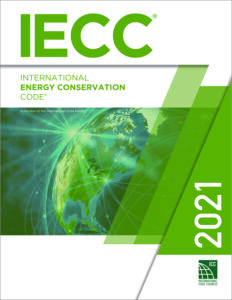
States are required to review their residential energy code and update their commercial energy code within two years of a positive determination from the Department of Energy that a new edition of the IECC saves energy.
Reasons to adopt the 2021 IECC fall into two categories: Energy Efficiency Improvements and New and updated provisions save energy, improve usability.
Energy Efficiency Improvements
On July 21, 2021, DOE Pacific Northwest Laboratory (PNNL) produced a final determination on the 2021 IECC representing a 9.4% site energy savings improvement and an 8.7% improvement in carbon emissions for residential buildings relative to the 2018 IECC, saving homeowners an average of $2,320 over the life of a typical mortgage. The U.S. Department of Housing and Urban Development (HUD) estimates that hard-working families will save over 35% on energy costs by building homes using the latest energy codes.
PNNL also produced analysis on the 2021 IECC commercial provisions on September 7, 2022, finding site energy savings of 12.1% and a 10.2% GHG emissions savings for commercial buildings relative to the 2018 IECC. The determination concluded that, on a national weighted average basis, the 2021 IECC is 6.5% more efficient for site energy use and 3.3% more for energy costs than Standard 90.1-2019.
DOE’s final residential determination can be found here, while the commercial analysis is available here.
The 2021 IECC represents an approximately 40% improvement in energy efficiency for residential and commercial buildings compared to the 2006 edition, meaning that residents in states and cities on older IECC editions would see far greater savings. Improvements in the residential and commercial provisions of the IECC since 2009 will provide over 350 million metric tons (MMT) of CO2 savings for residential buildings and 340 MMT for commercial buildings, totaling nearly 700 MMT of savings. The Department has also released data on energy, cost and GHG reductions each state and many cities could achieve by adopting the 2021 IECC, which are available here. The Code Council has compiled the homeowner-level benefits state-by-state including annual cost savings from updating to the 2021 IECC in this fact sheet.
If all states updated to the 2021 IECC, nationally over 22,000 jobs would be created in the first year and over 632,000 jobs cumulatively over 30 years.
Cumulative CO2 Savings from Each Edition of the IECC (2009-2021)
Each new edition of the energy code has provided for the cost-effective reduction of energy use. Implementation of the 2021 IECC is foundational to achieving energy savings and reductions on GHG emissions across building stock, both residential and commercial. According to the US Department of Energy, from 2010 to 2040, the model energy codes for residential and commercial buildings are projected to save:
- $138 billion energy cost savings
- 900 MMT of avoided CO2 emissions
- 13.5 quads of primary energy
These savings equate to the annual emissions of:
- 195 million passenger vehicles
- 227 coal power plants
- 108 million homes
For perspective, the primary energy consumption of the entire U.S. commercial and residential sectors in 2020 was estimated at 38 quads.
Resilience Benefits
The Department of Energy’s National Laboratories performed a 2023 study entitled Enhancing Resilience in Buildings Through Energy Efficiency, which provides standardized methodology and analysis demonstrating the value of building codes and above code measures to hazard resilience. The study reveals that improving envelope efficiency in buildings to meet or exceed current energy code requirements is a cost-effective strategy to save lives during extreme temperature events. Increasing the efficiency of the envelope in existing single-family buildings to meet code requirements of the 2021 IECC extends habitability by as much as 120% during extreme cold and by up to 140% during extreme heat. For new buildings, benefit-cost ratio (BCR) values for meeting 2021 IECC envelope requirements range from 2 to over 6 for single-family buildings, making a strong financial case for adoption.
New and updated provisions save energy, improve usability
Key changes to the 2021 IECC improve efficiency by 9.4 percent and reduce greenhouse gases by 8.7 percent over the 2018 IECC; these changes include new provisions that increase efficiency and encourage greater flexibility in design and construction as well as changes to existing requirements that provide clarification and improve usability of the code.
View a summary of key changes here.
Additional Energy Efficient Packages
Three new additional energy efficient package options, as shown in the figure below, were added to the 2021 IECC. This addition brings the total number of energy efficiency compliance options to eleven. The purpose of this section is to provide flexibility to achieve the energy savings needed to meet the overall energy savings goal of the code. These additional requirements come into play during the design phase where the designer has chosen the Prescriptive Compliance option. Where a designer pursues compliance via meeting ANSI/ASHRAE/IESNA 90.1 or is using the Total Building Performance approach, then Section C406 does not need to be addressed.
- More efficient HVAC performance
- Reduced lighting power
- Enhanced lighting controls
- On-site supply of renewable energy
- Dedicated outdoor air systems
- High-efficiency service water heating
- Enhanced envelope performance
- Reduced air infiltration
- Energy monitoring system
- Fault detection and diagnostics
- Efficient kitchen equipment
New Tropical Climate Zone Compliance Path
Tropical areas vary from the United States mainland in climate, construction techniques and energy prices. The new Tropical Climate Zone Compliance Path recognizes traditional tropical design characteristics encompassing shading, natural ventilation and the value of cool roofs. Mainland U.S. residential construction trends can minimize fenestration area, rely on dark roofing materials and overlook the value of external shading. Applied in tropical regions, these mainland construction trends result in overheated dwellings where natural ventilation is ineffective, yet the buildings lack the insulation and air sealing appropriate for any conditioned space. Additionally, tropical electrical prices make air conditioning infeasible for many households and, likewise, provide a substantial incentive for energy conservation.
Adoptable Appendix for Net Zero Energy Buildings
The 2021 IECC includes Zero Code appendices for both residential and commercial buildings.
The residential Zero Code appendix is based on the Energy Rating Index (ERI) path of the code, which requires more efficiency than is required in the base code and requires enough onsite or offsite renewable energy production to achieve an ERI score of zero. Renewable energy compliance may happen through a combination of onsite power production, energy generated through community renewable energy facilities, and renewable energy purchase contracts or leases.
The commercial Zero Code appendix is based on the Architecture 2030 ZERO Code. It requires a building to meet the minimum code requirements, plus enough on-site or off-site renewable energy to compensate for all the energy anticipated to be consumed by the building.
The Net Zero Energy provisions included in the 2021 IECC are not mandatory unless specifically referenced in the adopting ordinance. The provisions are included as appendices with the intention to provide options for jurisdictions with ambitious climate goals.
More information on Net Zero Energy – Building Operation Decarbonization can be found here.
Availability of DOE Funding to Support Implementation
Resilient and Efficient Codes Implementation
The Infrastructure Investment and Jobs Act (IIJA) has established the new Resilient and Efficient Codes Implementation (RECI) program, led by DOE, to award competitive grants for sustained cost-effective implementation of updated energy codes. This U.S. Department of Energy (DOE) competitive grant program has allocated $225 million, $45 million annually (FY22 through FY26), to support SLTT governments in the effective implementation of updated energy codes. Local governments must apply with a state agency and partnerships with public and private sector team members are encouraged.
To learn more about the Code Council's resilient and efficient codes solutions, access our factsheet.
Assistance for Latest and Zero Building Energy Code Adoption
The Inflation Reduction Act (IRA) provides $1 billion for states and local governments with the authority to adopt traditional building energy codes and innovative building energy codes, such as zero energy building codes and building performance standards, to lead the way in decarbonizing the new and existing residential and commercial buildings. The program is split into formula and competitive funding opportunities, which are outlined below.
Formula Program
DOE has released the Administrative and Legal Requirements Document (ALRD) for the formula grant funding portion of the Assistance for Latest and Zero Building Energy Code Adoption program, which provides additional information on eligible recipients, qualifying activities, and program guidance. Eligible states and territories must submit a letter of intent to IRACodes@hq.doe.gov by January 31, 2024, to reserve their funding, with full applications due by September 30, 2025. States are encouraged to submit a letter of intent irrespective of their current update status to assure potential future access to this funding. An optional template letter of intent is available to download. The formula funding breakdown includes:
To find out how much your state is eligible for please review the allocations from DOE by state.
Competitive Program
On December 18, 2023, the DOE issued a Funding Opportunity Announcement for $530 million in new competitive grant funding through the Assistance for Latest and Zero Building Energy Code Adoption program. Applicants must submit a Concept Paper by February 9, 2024 at 5pm ET to be eligible to submit a Full Application in the first round of funding. Applications will be accepted in three rounds, but DOE may elect to allocate all available funding in the first round of proposals. The first Full Application submission deadline is April 30, 2024 at 5pm ET. Additional information is available within the Code Council's Factsheet.
Visit ICC's Federal Grants Webpage for more details.
Other Grants for Energy Code Activities
The IIJA also established financial assistance through the Energy Efficiency and Conservation Block Grant Program (EECBG) and State Energy Program (SEP). DOE will determine allocations for these resources.
-
-
- $550 million is available through the EECBG to support development and implementation of energy codes; energy audits; energy efficiency, renewable energy, and zero-emission transportation financing; building retrofits; and installation of site renewable energy, among several delineated uses.
- $500 million is available for the SEP, until federal fiscal year 2026, to support development and implementation of energy codes; installation of renewable energy systems, energy and water efficiency upgrades, and EV charging stations; and financing programs, among several delineated uses.
-
Compliance and Enforcement
Adoption of the most recent model energy code is the first step to tapping into to cost-effective energy savings. Adoption should be followed by training and full implementation of the adopted code.
Although there is significant evidence of the value of energy code implementation, studies also show millions of dollars of untapped energy savings in states across the country. DOE has also observed, across 7 states studied, that training code officials on adopted codes can help reduce annual energy costs due to varying levels of code compliance by an average of about 45 percent.
Assessing the current construction practices, establishing compliance and enforcement goals, and accessing intake plan review inspection tools are the first steps to successful compliance and enforcement. Training requirements are equally important. The gap that exists between the efficiency levels required in codes and the efficiency levels achieved in the field is influenced by the extent of code official training on the energy code. Although about two-thirds of states require code official certifications, only seven states require training on energy code provisions.
DOE has updated its REScheck software tool to Version 2.1.0 to support its use with the 2021 IECC. REScheck is a free, web-based software application that supports builders, designers and contractors’ need to demonstrate that a particular residential structure complies with the IECC. The compliance software also assists building officials, plan reviewers and inspectors in making energy code compliance determinations. Learn more about REScheck here.
The use of Remote Virtual Inspections (RVI) has gained traction as an effective building inspection alternative in response to the COVID-19 Pandemic and local building inspection resource constraints, facilitating efficient and remote inspections utilizing modern technology. To support the effective implementation of RVI the International Code Council, in partnership with DOE’s Building Energy Codes Program, developed the Remote Virtual Inspection Protocols and checklist for Residential Energy Code Inspections for the 2018 and 2021 IECC. The RVI checklist can also be used to support onsite residential energy code inspections. Access the RVI Protocols and Checklist here.
More information on IECC Compliance and Enforcement can be found here.
Considerations for Adopting the 2021 IgCC
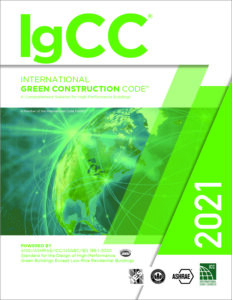
The 2021 edition of the IgCC offers essential sustainable construction building blocks on which future resilient initiatives can develop and expand. As jurisdictions continue to go beyond base codes to meet their robust climate and energy efficiency goals, the IgCC will be a critical part of the toolkit. The new edition provides:
- Written-in, enforceable code language and overlays with I-Codes;
- Extended scope to all areas of sustainable buildings and sites beyond energy conservation provisions of the IECC;
- Ability to customize which requirements to adopt through a Jurisdictional Options table;
- Appendix L, which aligns IgCC requirements with core elements of LEED versions 4.0 and 4.1;
Social Media Resources
Here are digital cards that you can post on social media that showcase the energy savings and efficiency of the 2021 International Energy Conservation Code®. Digital cards are available in 1200x630 and 1080x1080 dimensions.
1200x630 JPG – Good to use for Facebook, LinkedIn and Twitter
1200x630 JPG – Good to use for Facebook, LinkedIn and Twitter
1200x630 JPG – Good to use for Facebook, LinkedIn and Twitter
1200x630 JPG – Good to use for Facebook, LinkedIn and Twitter
1080x1080 JPG – Good to use for Instagram
1080x1080 JPG – Good to use for Instagram
1200x630 JPG – Good to use for Facebook, LinkedIn and Twitter
1080x1080 JPG – Good to use for Instagram
Partner Resources
American Council for an Energy Efficient Economy (ACEEE)
Architecture 2030
Energy-Efficient Codes Coalition (EECC)
Northeast Energy Efficiency Partnerships (NEEP)
- Misconceptions Surrounding Building Energy Codes and Affordable Housing
- Code Adoption
- Code Adoption Toolkit
- 2021 IECC Informational Videos
Polyisocyanurate Insulation Manufacturers Association (PIMA)
- State Energy Code Roofing Resources
- Energy and Carbon Emissions Savings Benefits of Roof Replacements

